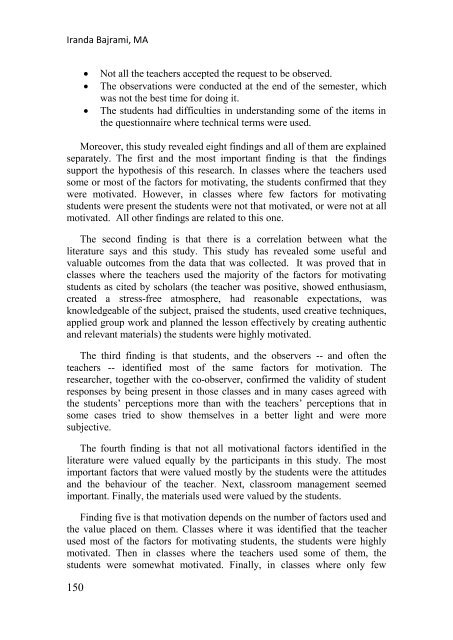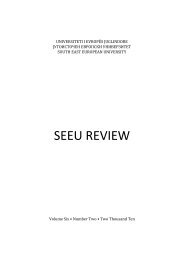SEEU Review vol. 5 Nr. 2 (pdf) - South East European University
SEEU Review vol. 5 Nr. 2 (pdf) - South East European University
SEEU Review vol. 5 Nr. 2 (pdf) - South East European University
You also want an ePaper? Increase the reach of your titles
YUMPU automatically turns print PDFs into web optimized ePapers that Google loves.
Iranda Bajrami, MA<br />
<br />
<br />
<br />
Not all the teachers accepted the request to be observed.<br />
The observations were conducted at the end of the semester, which<br />
was not the best time for doing it.<br />
The students had difficulties in understanding some of the items in<br />
the questionnaire where technical terms were used.<br />
Moreover, this study revealed eight findings and all of them are explained<br />
separately. The first and the most important finding is that the findings<br />
support the hypothesis of this research. In classes where the teachers used<br />
some or most of the factors for motivating, the students confirmed that they<br />
were motivated. However, in classes where few factors for motivating<br />
students were present the students were not that motivated, or were not at all<br />
motivated. All other findings are related to this one.<br />
The second finding is that there is a correlation between what the<br />
literature says and this study. This study has revealed some useful and<br />
valuable outcomes from the data that was collected. It was proved that in<br />
classes where the teachers used the majority of the factors for motivating<br />
students as cited by scholars (the teacher was positive, showed enthusiasm,<br />
created a stress-free atmosphere, had reasonable expectations, was<br />
knowledgeable of the subject, praised the students, used creative techniques,<br />
applied group work and planned the lesson effectively by creating authentic<br />
and relevant materials) the students were highly motivated.<br />
The third finding is that students, and the observers -- and often the<br />
teachers -- identified most of the same factors for motivation. The<br />
researcher, together with the co-observer, confirmed the validity of student<br />
responses by being present in those classes and in many cases agreed with<br />
the students’ perceptions more than with the teachers’ perceptions that in<br />
some cases tried to show themselves in a better light and were more<br />
subjective.<br />
The fourth finding is that not all motivational factors identified in the<br />
literature were valued equally by the participants in this study. The most<br />
important factors that were valued mostly by the students were the attitudes<br />
and the behaviour of the teacher. Next, classroom management seemed<br />
important. Finally, the materials used were valued by the students.<br />
Finding five is that motivation depends on the number of factors used and<br />
the value placed on them. Classes where it was identified that the teacher<br />
used most of the factors for motivating students, the students were highly<br />
motivated. Then in classes where the teachers used some of them, the<br />
students were somewhat motivated. Finally, in classes where only few<br />
150

















